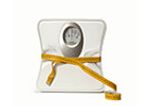A bit about BMI
by Guest Author,
- June 16, 2017
- Leave a comment

What is BMI?
Body Mass Index, or BMI, is one way to check if your weight is within a healthy range, based on your height.
BMI does not specifically measure body fat. But there is a moderate relationship between having a high BMI and a high level of body fat. Because it’s such a quick and simple measure, it’s used by health researchers and recommended by the World Health Organization as a way to measure and monitor body weight in populations. It is one way of checking whether your weight is putting your health at risk, as carrying excess body fat increases the risk of health problems, like type 2 diabetes, heart disease, fatty liver disease and 13 different types of cancers.
BMI is not the only measure of health! Knowing your BMI can help you understand how this risk factor affects you, but it’s important to remember that eating well and being active is great for your health regardless of your weight or shape.
How can I find out my BMI?
If you don’t know what your BMI is, you can use a BMI calculator online, like the LiveLighter BMI calculator. All you need is your current weight and height.
You can also calculate BMI yourself on a calculator, using the formula and instructions below.

Calculator instructions:
- Enter your weight in kilograms (kg)
- Press the (÷) button
- Enter your height in metres (m)
- Press the (÷) button
- Enter your height again in metres (m)
- Press the (=) button
For example, if someone weighs 82 kilograms and is 1.75 metres (175 centimetres) tall, the calculation of their BMI would be:
82 (weight) ÷ 1.75 (height) ÷ 1.75 (height) = 27
The BMI score is 27
Note that this BMI calculation is not suitable for children or teenagers. Use this calculator for people 2-20 years old
BMI, health risk and your body
Once you know what your BMI is, you can check to see if it’s within the healthy weight range. Take your BMI score from the calculation above, and see where it fits in the classifications below:
BMI Classification
Under 18.5 Underweight
18.5 - 25 Healthy weight
25 - 30 Overweight
30+ Obese
As with most health measures, BMI is not perfect – but it’s a good place to start!
Be careful interpreting your BMI result if you belong to one of these groups. It’s less accurate for:
|
 |
If you would like more information about your BMI, or any other health risk factors, see your doctor for advice.
What about waist circumference?
There are other, more accurate ways than BMI to specifically measure body fat, but they can take a long time, need trained staff and specialised equipment.
So, besides BMI, are there any other easy ways of knowing if we could be carrying too much fat? There is one way that is pretty simple, and you may have heard of it – measuring your waist circumference. Waist measurement is a good predictor of future disease risk. It relates to the amount of body fat around our belly, in other words, the toxic visceral fat that surrounds our organs. Having a large waist circumference might mean we have too much fat around our middle, which can put us at a higher risk of future disease.
You can measure your waist circumference (or ask a health professional to measure it) by:
- Finding the top of your hip bones and the bottom of your ribs
- Placing the tape measure at the narrowest part between these points and wrapping it around your waist
- Breathing out normally
- Reading the measurement on the tape, and comparing this to the measurements below

In conclusion…
BMI is easy, quick and simple to calculate. It’s useful for checking if your weight is within the healthy range, or if it is putting your health at risk. If you can measure your waist as well, even better!
BMI is one measurement and is best considered along with other risk factors when assessing your individual risk. To get a more in-depth health picture, book an appointment to see your doctor. They can look at other health markers like blood pressure and cholesterol and give you advice that is specific to your body and health.







